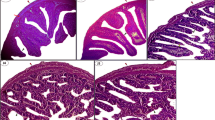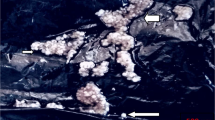Abstract
Selenium (Se) is recognized as a necessary trace mineral in animal diets, including those of birds. Lead (Pb) is a toxic heavy metal and can damage organs in humans and animals. Complex antagonistic interactions between Se and heavy metals have been reported in previous studies. However, little is known regarding the effects of Se on Pb-induced toxicity and the expression of inflammatory factors and heat shock proteins (HSPs) in the cartilage of chickens. In this present study, we fed chickens either with Se or Pb or both Se and Pb supplement and later analyzed the mRNA expressions of inflammatory factors (inducible nitric oxide synthase (iNOS), nuclear factor-kappa B (NF-κB), tumor necrosis factor-α (TNF-α), and cyclooxygenase-2 (COX-2)) and HSPs (Hsp27, Hsp40, Hsp60, Hsp70, and Hsp90). The results showed that Se and Pb influenced the expression of inflammatory factors and HSP genes in the chicken cartilage tissues. Additionally, we also found that antagonistic interaction existed between Se and Pb supplementation. Our findings suggested that Se could exert a antagonistic effect on Pb in chicken cartilage tissues.







Similar content being viewed by others
References
Adonaylo VN, Oteiza PI (1999) Lead intoxication: antioxidant defenses and oxidative damage in rat brain. Toxicology 135:77–85
Flora SJ, Pande M, Mehta A (2003) Beneficial effect of combined administration of some naturally occurring antioxidants (vitamins) and thiol chelators in the treatment of chronic lead intoxication. Chem Biol Interact 145:267–280
Fisher IJ, Pain DJ, Thomas VG (2006) A review of lead poisoning from ammunition sources in terrestrial birds. Biol Conserv 131:421–432
Hartup BK (1996) Rehabilitation of native reptiles and amphibians in DuPage County, Illinois. J Wildl Dis 32:109–112
Roschger JG, Hofstaetter B, Pemmer Z et al (2013) Differential accumulation of lead and zinc in double-tidemarks of articular cartilage. Osteoarthr Cartil 21:1707–1715
Yıldızgören M T., Baki A E, Kara M, et al. (2014) Ultrasonographic measurement of the femoral cartilage thickness in patients with occupational lead exposure, J Expo Sci Environ Epidemiol. 1-3
Zoeger N, Roschger P, Hofstaetter JG et al (2006) Lead accumulation in tidemark of articular cartilage. Osteoarthr Cartil 14:906–913
Ates B, Orun I, Talas ZS, Durmaz G, Yilmaz I (2008) Effects of sodium selenite on some biochemical and hematological parameters of rainbow trout (Oncorhynchus mykiss Walbaum, 1792) exposed to Pb2+ and Cu2+. Fish Physiol Biochem 34:53–59
Bogdan C (2001) Nitric oxide and the immune response. Nat Immunol 2:907–916
Cogswell JP, Godlevski MM, Wisely GB et al (1994) NF-kappa B regulates IL-1 beta transcription through a consensus NF-kappa B binding site and a nonconsensus CRE-like site. J Immunol 153:712–723
Raabe T, Bukrinsky M, Currie RA (1998) Relative contribution of transcription and translation to the induction of tumor necrosis factor-alpha by lipopolysaccharide. J Biol Chem 273:974–980
Yuan CJ, Mandal AK, Zhang Z, Mukherjee AB (2000) Transcriptional regulation of cyclooxygenase-2 gene expression: novel effects of nonsteroidal anti-inflammatory drugs. Cancer Res 60:1084–1091
Das S, Santra A, Lahiri S, Guha Mazumder DN (2005) Implications of oxidative stress and hepatic cytokine (TNF-alpha and IL-6) response in the pathogenesis of hepatic collagenesis in chronic arsenic toxicity. Toxicol Appl Pharmacol 204:18–26
Xing M, Zhao P, Guo G et al (2015) Inflammatory factor alterations in the gastrointestinal tract of cocks overexposed to arsenic trioxide. Biol Trace Elem Res 167:288–299
Du Y, Zhu Y, Teng X et al (2015) Toxicological effect of manganese on NF-kappaB/iNOS-COX-2 signaling pathway in chicken testes. Biol Trace Elem Res 168:227–234
Bernabo P, Rebecchi L, Jousson O et al (2011) Thermotolerance and Hsp70 heat shock response in the cold-stenothermal chironomid Pseudodiamesa branickii (NE Italy). Cell Stress Chaperones 16:403–410
Chen H, Xu XL, Li YP, Wu JX (2014) Characterization of heat shock protein 90, 70 and their transcriptional expression patterns on high temperature in adult of Grapholita molesta (Busck). Insect Sci 21:439–448
Ramaglia V, Harapa GM, White N, Buck LT (2004) Bacterial infection and tissue-specific Hsp72, -73 and -90 expression in western painted turtles. Comp Biochem Physiol Toxicol Pharmacol : CBP 138:139–148
Lee J, Lim KT (2012) Inhibitory effect of SJSZ glycoprotein (38 kDa) on expression of heat shock protein 27 and 70 in chromium (VI)-treated hepatocytes. Mol Cell Biochem 359:45–57
Klotz LO, Kroncke KD, Buchczyk DP, Sies H (2003) Role of copper, zinc, selenium and tellurium in the cellular defense against oxidative and nitrosative stress. J Nutr 133:1448S–1451S
Yao H, Liu W, Zhao W et al (2014) Different responses of selenoproteins to the altered expression of selenoprotein W in chicken myoblasts. RSC Adv 4:64032–64042
Liu C, Fu J, Liu C, Li S (2015) The role of nitric oxide and autophagy in liver injuries induced by selenium deficiency in chickens. RSC Adv 5:50549–50556
Jiang ZH, Khoso PA, Yao HD et al (2015) SelW regulates inflammation-related cytokines in response to H2O2 in Se-deficient chicken liver. RSC Adv 5:37896–37905
Orun I, Talas ZS, Ozdemir I, Alkan A, Erdogan K (2008) Antioxidative role of selenium on some tissues of (Cd2+), Cr3+)-induced rainbow trout. Ecotoxicol Environ Saf 71:71–75
Chen X, Zhu YH, Cheng XY, Zhang ZW, Xu SW (2012) The protection of selenium against cadmium-induced cytotoxicity via the heat shock protein pathway in chicken splenic lymphocytes. Molecules 17:14565–14572
Han XJ, Xiao YM, Ai BM et al (2014) Effects of organic selenium on lead-induced impairments of spatial learning and memory as well as synaptic structural plasticity in rats. Biol Pharm Bull 37:466–474
Zhang JL, Zhang ZW, Shan AS et al (2014) Effects of dietary selenium deficiency or excess on gene expression of selenoprotein N in chicken muscle tissues. Biol Trace Elem Res 157:234–241
Bjerregaard P, Fjordside S, Hansen MG, Petrova MB (2011) Dietary selenium reduces retention of methyl mercury in freshwater fish. Environ Sci Technol 45:9793–9798
Shao CC, Li N, Zhang ZW et al (2014) Cadmium supplement triggers endoplasmic reticulum stress response and cytotoxicity in primary chicken hepatocytes. Ecotoxicol Environ Saf 106:109–114
Wang H, Li S, Teng X (2015) The antagonistic effect of selenium on lead-induced inflammatory factors and heat shock proteins mRNA expression in chicken livers. Biol Trace Elem Res. doi:10.1007/s12011-015-0532-z
Gao H, Liu CP, Song SQ et al (2015) Effects of dietary selenium against lead toxicity on mRNA levels of twenty-five selenoprotein genes in the cartilage tissue of broiler chicken. Biol Trace Elem Res. doi:10.1007/s12011-015-0579-x
Karin M, Yamamoto Y, Wang QM (2004) The IKK NF-kappa B system: a treasure trove for drug development. Nat Rev Drug Discov 3:17–26
Surh YJ, Chun KS, Cha HH et al (2001) Molecular mechanisms underlying chemopreventive activities of anti-inflammatory phytochemicals: down-regulation of COX-2 and iNOS through suppression of NF-kappa B activation. Mutat Res 480–481:243–268
Kumawat KL, Kaushik DK, Goswami P, Basu A (2014) Acute exposure to lead acetate activates microglia and induces subsequent bystander neuronal death via caspase-3 activation. Neurotoxicology 41:143–153
Barbhuiya SASK, Chakraborty S, Sengupta M (2013) Studies of lead toxicity on inflammatory damage and innate immune functions in testicular macrophages of male Swiss albino mice. Mod Res Inflamm 2:75–81
Lindquist S, Craig EA (1988) The heat-shock proteins. Annu Rev Genet 22:631–677
Liu CP, Fu J, Xu FP, Wang XS, Li S (2015) The role of heat shock proteins in oxidative stress damage induced by Se deficiency in chicken livers. Biometals 28:163–173
Yang QL, Yao CL, Wang ZY (2012) Acute temperature and cadmium stress response characterization of small heat shock protein 27 in large yellow croaker, Larimichthys crocea. Comp Biochem Physiol Toxicol Pharmacol : CBP 155:190–197
Guo Y, Zhao P, Guo G et al (2015) Effects of arsenic trioxide exposure on heat shock protein response in the immune organs of chickens. Biol Trace Elem Res Biol. doi:10.1007/s12011-015-0389-1
Kohler HR, Alberti G, Seniczak S, Seniczak A (2005) Lead-induced Hsp70 and Hsp60 pattern transformation and leg malformation during postembryonic development in the oribatid mite Archegozetes longisetosus Aoki. Comp Biochem Physiol Toxicol Pharmacol : CBP 141:398–405
Rayman MP (2000) The importance of selenium to human health. Lancet 356:233–241
Liu S, Xu F, Fu J, Li S (2015) Protective roles of selenium on nitric oxide and the gene expression of inflammatory cytokines induced by cadmium in chicken splenic lymphocytes. Biol Trace Elem Res 168:252–260
Liu LL, Zhang JL, Zhang ZW et al (2014) Protective roles of selenium on nitric oxide-mediated apoptosis of immune organs induced by cadmium in chickens. Biol Trace Elem Res 159:199–209
Xu Z, Wang Z, Li JJ et al (2013) Protective effects of selenium on oxidative damage and oxidative stress related gene expression in rat liver under chronic poisoning of arsenic. Food Chem Toxicol 58:1–7
Xu T, Gao X, Liu G (2015) The antagonistic effect of selenium on lead toxicity is related to the ion profile in chicken liver. Biol Trace Elem Res. doi:10.1007/s12011-015-0422-4
Acknowledgments
This work was supported by China Postdoctoral Science Foundation (No. 2012 M520702); the National Natural Science Foundation of China (31402267); the Start-up Foundation for Doctors of Northeast Agricultural University, China (No. 2012RCB92); Heilongjiang Province Science Foundation for Youths (QC2014C015); Heilongjiang Provincial Department of Education Science and Technology research project (No. 12541024); Foundation for Young Talents in Higher Education of Heilongjiang, China (UNPYSCT-2015009); the Young Talents Project of Northeast Agricultural University (No. 14QC18, No. 14QC20); the International Postdoctoral Exchange Fellowship Program (No. 20130006); and the Students Innovative Training (SIPT) program of Northeast Agricultural University (No. 201510224109, 201510224110).
Author information
Authors and Affiliations
Corresponding authors
Additional information
All other authors have read the manuscript and have agreed to submit it in its current form for consideration for publication in the journal.
Shu Fang Zheng and HuanYu Song contributed equally to this work.
Rights and permissions
About this article
Cite this article
Zheng, S., Song, H., Gao, H. et al. The Antagonistic Effect of Selenium on Lead-Induced Inflammatory Factors and Heat Shock Protein mRNA Level in Chicken Cartilage Tissue. Biol Trace Elem Res 173, 177–184 (2016). https://doi.org/10.1007/s12011-016-0630-6
Received:
Accepted:
Published:
Issue Date:
DOI: https://doi.org/10.1007/s12011-016-0630-6




